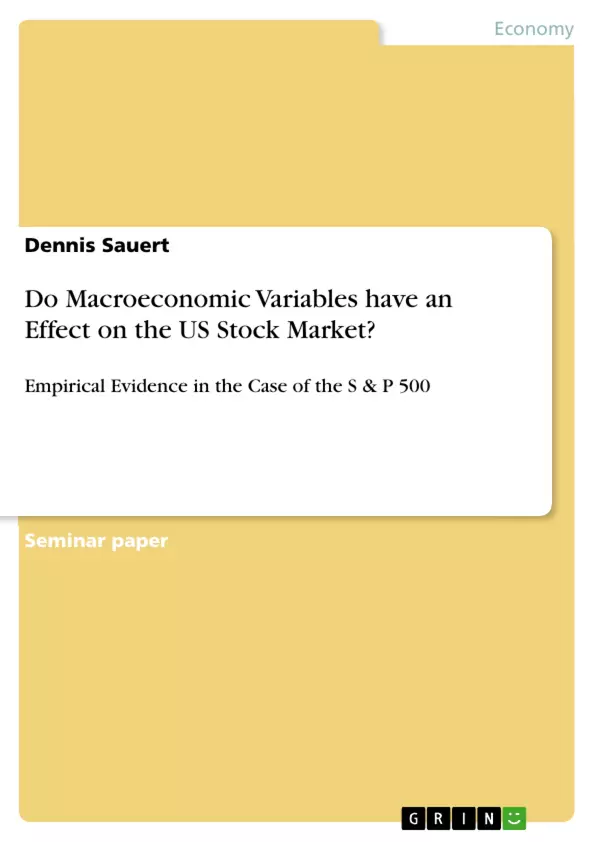The objective of this paper is to examine whether the unanticipated change of specific macroeconomic variables influences the US stock market represented by the S&P 500 using monthly data from 1986 to 2007. Thereby, the performance of the arbitrage pricing theory of
Ross (cp. Ross, S., 1976) shall be studied. To explain the behavior of the US stock market return the paper contains the five predefined variables consumer price index (CPI), industrial production index (IPT), money stock M1 (M1), total consumer credit outstanding (TCC) and the term structure of interest rates (Term) which are approximately similar to those variables used by Ross (cp. Chen N. F. et al., 1986, pp. 383-403). Applying the OLS method, it was found that CPI, IPT and Term are negatively related to the US stock return. It was also detected that M1 affects the stock market lagging 8 months and 12 months. However, the test statistics showed
that TCC has rather no impact on the US stock market return. To ensure that the ultimate results are not spurious, care will be taken in regards to autocorrelation, multicollinearity, serial correlation as well as heteroskedasticity.
Inhaltsverzeichnis (Table of Contents)
- Abstract
- Introduction
- Applied Macroeconomic Time Series Data Source
- Standard & Poor's 500 Index
- Stock Prices and Industrial Production Index
- Stock Return and M1 Money Stock
- Stock Return and Total Consumer Credit Outstanding
- Stock Return and Term Structure of Interest Rates
- Stock Return and Consumer Price Index
- The Expected Outcome of Regressors
- Analysis of Test Results
- Stationarity and Weak Dependence
- Testing for Time Trend and I(1) process
- Lagged Variables
- Multicollinearity
- Model Re-Specification
- Regression Results
- F-Test
- Serial Correlation
- Testing for Heteroskedasticity
- Model Re-Specification
Zielsetzung und Themenschwerpunkte (Objectives and Key Themes)
This paper aims to investigate the influence of unanticipated changes in specific macroeconomic variables on the US stock market, represented by the S&P 500. Using monthly data from 1986 to 2007, the study examines the performance of the arbitrage pricing theory (APT) of Ross. It explores the relationship between the US stock market return and five predefined variables: consumer price index (CPI), industrial production index (IPT), money stock M1 (M1), total consumer credit outstanding (TCC), and the term structure of interest rates (Term). The analysis focuses on identifying whether these macroeconomic variables have a significant impact on the stock market and how they interact with each other.
- The influence of unanticipated changes in macroeconomic variables on the US stock market.
- The performance of the arbitrage pricing theory (APT) of Ross in explaining stock market returns.
- The relationship between the US stock market return and specific macroeconomic variables, including CPI, IPT, M1, TCC, and Term.
- The identification of significant impacts of macroeconomic variables on stock market performance.
- The assessment of the interaction between macroeconomic variables and their influence on stock market returns.
Zusammenfassung der Kapitel (Chapter Summaries)
The paper begins with an introduction that establishes the context of the relationship between the financial market and the macroeconomy, outlining the focus on explaining US stock market returns as a function of macroeconomic variables. The introduction emphasizes the arbitrage pricing theory (APT) of Ross and its core assumption that stock returns are influenced by unexpected changes in macroeconomic variables.
Chapter 2 provides an in-depth look at the applied macroeconomic time series data source, detailing the five variables used in the study: CPI, IPT, M1, TCC, and Term. The chapter explains the data collection process, data availability, and the rationale for using these specific variables based on the APT framework. This chapter also clarifies the choice of a log-log model and the use of differences in variables to capture unexpected changes.
Chapter 3 outlines the expected outcome of the regressors, providing a theoretical foundation for the analysis. This section is likely to present the expected relationships between the macroeconomic variables and the stock market return based on existing economic theory and prior research.
Chapter 4 delves into the analysis of test results, focusing on various statistical tests employed to validate the model and ensure the reliability of the findings. It examines stationarity, weak dependence, time trend, I(1) process, lagged variables, multicollinearity, and model re-specification. This chapter also presents the regression results, highlighting the relationships between each independent variable and the US stock market return.
Chapter 5 discusses the F-test, a statistical test used to assess the overall significance of the model. This chapter examines the significance of the regression model as a whole, indicating whether the combined impact of the macroeconomic variables is statistically significant in explaining the variation in stock market returns.
Chapter 6 delves into the issue of serial correlation, exploring the possibility of correlations between error terms in the regression model. This chapter seeks to ensure that the results are not affected by autocorrelation, which could lead to biased estimates.
Chapter 7 focuses on testing for heteroskedasticity, investigating the presence of unequal variances in the error terms across the data set. This chapter aims to ensure that the regression results are not distorted by heteroskedasticity, which can affect the accuracy of standard errors and hypothesis tests.
Schlüsselwörter (Keywords)
This research focuses on the relationship between macroeconomic variables and the US stock market. The key concepts explored include the arbitrage pricing theory (APT), unexpected changes in macroeconomic variables, log-log model, OLS regression, stationarity, weak dependence, time trend, I(1) process, lagged variables, multicollinearity, model re-specification, F-test, serial correlation, and heteroskedasticity. The study examines the impact of CPI, IPT, M1, TCC, and Term on the US stock market return as represented by the S&P 500. These keywords encapsulate the core themes and methods employed in this empirical investigation.
- Quote paper
- Dennis Sauert (Author), 2010, Do Macroeconomic Variables have an Effect on the US Stock Market?, Munich, GRIN Verlag, https://www.grin.com/document/158131



